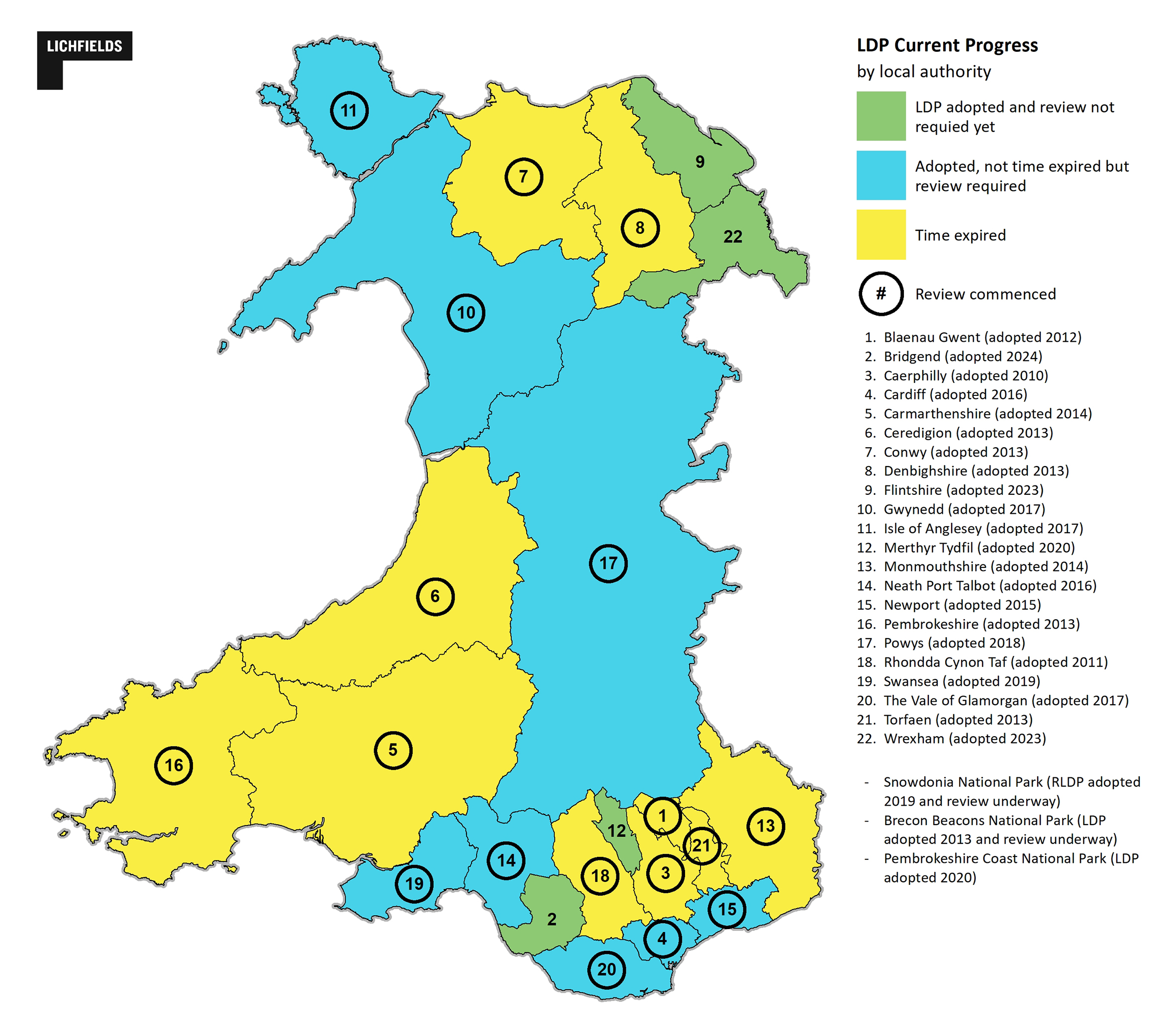With only 4,771 housing completions
[1] in 2023/24—the lowest
[2] since record-keeping began in 1974—urgent action is needed to address the systemic barriers impeding progress to the delivery of new homes in Wales.
The housing crisis in the UK has reached alarming levels, particularly in Wales, where a recent Audit Wales report
[3] highlights the slow delivery and rising costs of delivering affordable homes.
Within the last 20-years, housing delivery in Wales was at its peak in the early 2000s where on average 8,558 dwellings were completed per annum. Completions fell following the 2008 financial crash to a low of 5,451 dwellings in 2012/13 before slowly recovering to 6,900 in 2015/16. As a result of the pandemic, the number of completions dropped significantly during 2020/21 to 4,616 before rising to 5,785 in 2022/23.
Dwellings Completions 2002- 2024
The Future Wales estimate of need of 7,400 dwellings per annum in the first five years of the Plan has never been met. This is even more concerning when taking into account that the need identified in Future Wales is based on past build rates and demographic trends. Some would argue that Future Wales fails to leverage the full potential of planning policy to deliver change by, for example, tackling Wales’ rapidly ageing demographic profile.
To better understand some of the barriers to housing delivery the Competition and Markets Authority (CMA) published a paper
[4] on housebuilding in the UK in February 2024. A specific summary was provided in relation to Wales. It stated that it would like to see a housebuilding market that delivers:
- More homes overall, and particularly in the areas of highest demand, in turn reducing pressure on affordability;
- Consistently better outcomes on new build quality, with consumers having an effective route to redress; and,
- Reduced detriment to consumers arising from the private management of amenities on new build estates.
The CMA report made specific recommendations in terms of reforming the planning system. Some of these include:
Option 2.1: More objective and effective use of targets to ensure housing need is met.
Option 2.2: Effective monitoring and enforcement of local development plans to encourage housebuilders to bring forward successful planning applications and build new houses.
Option 2.3: Streamlining the planning system to significantly increase the ability of housebuilders to begin work on new projects sooner and bring forward marginal projects which may have previously not been viable due to the costs of taking them forward. Potential easy gains here could include limiting the use of pre commencement conditions and utilising standardised s106 agreements.
There are other important recommendations such as the need to reduce delay of statutory consultee responses, improve capacity within local planning authorities, simplifying the outline planning process and incentivising the delivery of small sites.
The Labour Government in England seem to have taken on board the CMA’s recommendations and, within weeks of taking power, it had proposed a challenging housing target for England of 370,000 new homes per annum and to revoke previous changes that eased the requirement on local planning authorities in respect of the need to demonstrate a five-year supply of housing. If successful, this would double the national annual level of housing output delivered in recent years. Deputy Prime Minster Angela Rayner sees this as a way of not only getting homes delivered but to drive growth and create jobs. A brief general response to the CMA report has been provided by Jayne Bryant MS and we look forward to seeing the full response in due course.
Lichfields would welcome a detailed assessment of housing needs across Wales. Whilst there has been analysis of affordable housing needs, the assessments of wider market needs are primary based on demographic trends which take no account of factors such as concealed households or policy ambition.
As a result, Lichfields is concerned that housing requirements in emerging RLDPs are underestimating actual housing needs, particularly as past build rates are being used as a benchmark of what is considered deliverable. At a time of acknowledged crisis in housing provision, RLDPs are in danger of simply rolling forward past patterns of historic under delivery which cannot be seen as aspirational policy in the context of achieving the well-being goals. A stock-based approach to assessing housing requirements is, in our view, more likely to trigger the necessary step-change in housing delivery.
Welsh Government has recently announced a ‘deep dive’ into the barriers of delivering affordable housing at pace and also a consultation
[5] on promoting a resilient and high performing planning service. This indicates a recognition that there are delivery issues, as highlighted by the CMA and Audit Wales in their recent reports. However, we consider that these issues go beyond just affordable housing delivery and are primarily rooted in procedural and political challenges in producing ambitious and timely LDPs.
Delivering LDP Targets
The Welsh Government prioritises a plan-led system, in the same way as the rest of the UK. However, this long-held cornerstone of our planning system only works where development plans are updated regularly and without delay. LDPs identify the land required to deliver new homes and need regular review to replenish those sites that have either been built out or that have failed to come forward for reasons such as viability. Of course, local plans can also become out of date in England, but the new Government has acted to ensure that there are policies and mechanisms in place to allow alternative sustainable sites to come forward outside of the Plan process to deliver a continuing supply of new homes.
In Wales, every LPA should currently review its LDPs no longer than four years from the date of adoption
[6]. Delays in LDP preparation have been widespread across Wales, with only seven out of 25 plans being less than five years old. Of the remaining 18 LDPs, 11 are time expired and therefore fail to offer a robust basis for forward planning and associated investment decisions.

In the absence of either up-to-date LDPs or alternative policy sanctions there is no incentive in Wales to ensure that LPAs are delivering the required amount of housing, and little incentive for elected Members to vote to adopt a controversial new LDP. Neither is there the flexibility to bring forward sustainable housing sites quickly to resolve critical housing shortages. The latest Welsh Government consultation on a resilient planning system seeks views on extending the LDP review period from four to six years. We believe that an implication of this change would be to make the need for the monitoring of land supply and reacting to any identified shortages, even more crucial.
In 2018, at a time when housing delivery in Monmouthshire had been below the LDP targets, working collaboratively with the Council, Lichfields obtained outline planning permission for 115 dwellings on a site in Llanfoist, Abergavenny outside the settlement boundary. The proposal included 35% affordable housing (above the policy target) and the permission was subject to a condition requiring submission of an application for the approval of Reserved Matters within 12 months. The purpose of this was to expedite the delivery of houses on the site. Despite, the contractor going into administration mid-development, the site is approaching completion, delivering 69 market homes and 37 affordable homes. The LDP became time expired in 2021 and the replacement LDP is unlikely to be in place until 2026 at the earliest. However, due to the Welsh Government’s removal of TAN1 and the five-year housing land supply test, valuable sustainable developments (with increased affordable housing and accelerated delivery timescales) such as the site in Llanfoist are no longer able to come forward to plug the gaps whilst LDPs are being updated or are not delivering.
It is understood that Welsh Government is working with LPAs to try to improve up-to-date LDP coverage across Wales. However, we consider that a new policy mechanism is also required to ensure the planning process is more responsive to supply shortages. This is something Welsh Government could address in the short term through a new policy requirement to ensure housing delivery is reflecting LDP housing trajectories.
Lichfields propose that such a mechanism could monitor delivery against LDP anticipated annual build rate (AABR) and allow for short-term sustainable housing land releases ahead of LDP review where urgent land shortages are evident. This would make the planning system in Wales more resilient and support the social and economic objectives set out in Future Wales and PPW as well as assisting the Welsh Government in meeting its 20,000 affordable homes target.
A new policy mechanism for addressing housing shortfalls against agreed trajectories would not only address this need but would also encourage LPAs to ensure that up-to-date LDPs are in place. If LPAs have up-to-date LDPs they are more likely to be delivering against trajectories and retain control over where new housing is located.
Any new policy statement allowing for short-term releases would still need to ensure that housing sites reflect key government planning principles including:
-
Sustainable location with good active travel links;
-
Affordable housing in line with policy requirements;
-
Accordance with place making principles; and,
-
Achievement of net biodiversity benefit requirements.
20,000 new low carbon affordable homes
The Welsh Government’s housing planning policy is overwhelmingly focused on affordable housing delivery. Increased open market house building would, in Lichfields’ view, enhance affordable housing delivery by ensuring the private sector deliver considerable numbers of affordable homes through Section 106 agreements. It would also provide valuable housing for the skilled workforce that Welsh Government are trying to grow in Wales.
The consequence is that whilst the proportion of affordable housing delivery may at first glance be increasing, this is only as part of diminishing overall output.
Welsh Government has a target of delivering 20,000 new low carbon homes for rent between 2021 and 2026. Welsh Government Affordable Housing Provision data records a net increase of 6,045 affordable homes between 2021 and 2023. This figure, however, includes acquisition of existing stock. Based on Stats Wales Housing Completion data the actual number of new build affordable dwellings was 3,825. Of these 1,738 (45%) were delivered via Section 106 agreements from private enterprise schemes. Welsh Government has recently launched a ‘deep dive’ to understand why affordable housing delivery is falling short of the 20,000 target
[7]. In Lichfields’ view the CMA report has already identified many of the key issues that require addressing.
Whilst investment in affordable housing schemes is to be commended, this is happening at significant cost to Welsh Government budgets, and it is unclear how sustainable this is in the medium term. There is a private house building sector that accepts affordable housing delivery forms part of the policy environment in Wales and is willing to play its part in addressing the shortfalls. We believe that a policy focus on increased private sector output would be a more cost-effective way to increase affordable housing delivery and reflect the concerns raised in the Audit Wales report.
The current low levels of house building are undermining achievement of the seven well-being goals. The planning system has a real opportunity to address these matters and make use of the house-building sector as a vehicle to significantly boost the Welsh economy. Rachel Reeves has repeatedly referred to the importance of increased house building to achieving economic growth in England; this is surely something that we should also be aspiring to in Wales.
Whilst there are issues in the development management process that require addressing (primarily additional resources and expertise), the real blockage in housing delivery lies in the procedural and political challenges of the plan-making process and lack of any policy mechanism to allow for appropriate sites to come forward in the short term where there is evidence that housing trajectories are not being met. We believe that these are issues that warrant urgent attention and action.
This article first appeared in the Winter 2024 edition of Cynllunio, the journal of RTPI Cymru.
Footnotes
[1] New dwellings completed by period and tenure - Stats Wales
[2] With the exception of 2020/21 that was impacted by the covid-19 pandemic where construction sites were shut down.
[3] Affordable Housing - Audit Wales
[4] Housebuilding market study - Competition and Markets Authority
[5] Promoting a resilient and high performing planning service - Welsh Government
[6] PCPA 2004 (Section69 (1)) and LDP Regulation 41 (1)
[7] Social Housing Supply- Welsh Parliment Local Government and Housing committee




